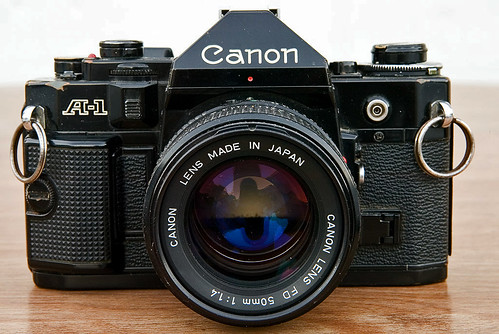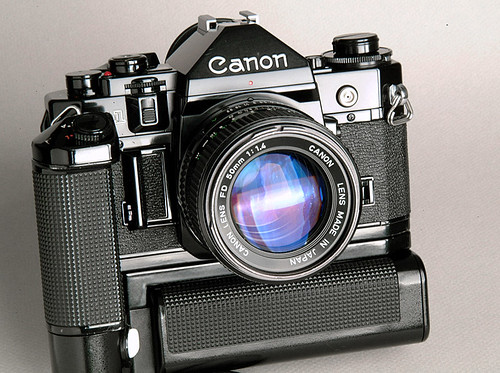Canon A-1

|
| Canon A-1 with 50mm f/1.4 lens image by pointnshoot (Image rights) |
The A-1 is a 35mm SLR camera from Canon that, like its predecessor the AE-1, was innovative when released in 1978.
It was notable for its programmed automatic exposure setting, whereby both aperture and shutter speed are automated. While not labelled as such, it was a pioneer in offering the full "PASM" set of exposure options, standard in many later cameras through the present day. Canon's competitors were considerably slower in introducing programmed SLRs: Minolta in 1982 with the X-700, Nikon with the FA and Pentax with the Super A in 1983 and Olympus with the OM-2S Program in 1984.
The A-1 has the Canon FD bayonet lens mount and was normally sold with the Canon FD 50mm f/1.8 or 50mm f/1.4 lens. The A-1 accepts any lens with the Canon FD (1971) or FDn (1979) bayonet mount. The lenses feel solid, and are well-finished and balanced. (The more recent EF mount autofocus lenses (1987) cannot be fitted, nor can the FD mount lenses be fitted to autofocus Canon SLRs.)
The A-1 has the choice of aperture- or shutter-priority automatic exposure, the first[1] "programmed" fully-automatic exposure mode, as well as automatic dedicated flash, and a fully manual setting. There is a numerical display in the viewfinder of shutter and aperture, using red LED seven-segment displays. To avoid fogging from the viewfinder on long exposures, the LED display can be switched off, and the eyepiece closed off with a shutter.
The settings dial is shown (right) set to shutter-priority auto ("Tv"). The programmed setting (marked [P] in a green square) is just past the 1/1000 mark. Rotating the collar around the shutter-release to "Av" sets aperture-priority and changes the scale from speed (black background) to aperture settings (on a yellow background). Speeds (manual or auto), or apertures (in auto mode) are adjusted by a wheel in front of the dial; the photographer's right index finger naturally falls on this. There is a sliding cover for the wheel, preventing accidental changes to settings. The A-1 does not have a mirror lock.
For automatic operation, the aperture ring of the lens is set to the "A" position; for manual settings, the required aperture is set on the lens and the shutter set on the dial, in the "Tv" position. On the photographer's left, on the front is a peculiar slider, with a flip-up finger pad, which is the stop-down lever for depth of field preview and stop-down metering. On the side of the lens mount are buttons for exposure preview, and exposure memory. Around the rewind crank is the film speed setting dial, with ±2 stop exposure compensation adjustment.

|
| Hot shoe with dedicated flash contacts image by AWCam (Image rights) |

|
| A-1 settings dial image by AWCam (Image rights) |
The electronically-controlled horizontal cloth focal plane shutter has marked speeds from 30s to 1/1000s, with X-synchronisation at 1/60 second (there is no bulb synch setting). In aperture priority mode, the shutter speed is continuously variable. The cloth shutter is known to stick at times. Even moderately well-used examples of the camera (and the AE-1) develop a distinctive "squeal"; this can be corrected by re-lubricating the mirror braking mechanism. If this is not done, the fault can eventually lead to permanent damage. It is also not uncommon to see broken or taped-up battery doors on used models.
Dedicated flashguns can be attached to the hot shoe, where there are two additional contacts for camera-gun communication. There is also a PC socket - on the front, near the rewind crank - for a conventional flashgun.
Around the wind-on lever is the On (A)/ Off (L, lock)/ self-timer (2 or 10 sec) switch, and also a double-exposure release - allowing cocking the shutter without advancing the film {this is covered by the lever in the photo above}. The base of the A-1 has electrical contacts and a mechanical linkage for a motor drive, as well as the tripod bush and rewind release.
The A-1 was among the first cameras to be completely dependent on battery power. This power came from a 6V PX28A battery, or four LR44 1.5V alkaline cells, kept in a battery compartment on the front, partly hidden by a screwed-on finger grip (the "Action Grip"[2]). Unlike most other Canon SLRs, the A-1 was only available in black finish.
The Canon A-1 is superior to the AE-1 in almost every respect. Despite this, its market-value is somewhat lower. This may be because are relatively few AE-1s are still fully functional, while A-1s have survived well.
The AE-1 was one of Canon's first forays in cost-cutting by using plastics pervasively in camera assemblies. The A-1 was built far more robustly, and uses machined gears in contrast to the metalized plastic gears of both the AE-1 and AE-1 Program. Furthermore, the A-1 offers aperture priority and lower shutter speeds, although the metering system is the same as that of the AE-1 Program.

|
| Canon A-1 with Motor Drive image by Geoff Harrisson (Image rights) |
Notes
- ↑ According to Canon, in their museum
- ↑ named in the manual
Links
In English:
- Canon A-1 at Photography in Malaysia
- Canon A-1 and AV-1 at The Camera Site by Reijo Lauro
- A-1 in Canon's Museum
- Canon A1 Camera Manual : Photo-Manuals.com
- Canon A-1 Price Data at Camera Repair dot Com's price data
- Canon a-1 at Classic Cameras by RaúlM.
- The A Team an article about the SLR A models, AE-1, AT-1, A-1, AV-1 and AE-1 Program at Classic Cameras by RaúlM.
In French:
- Lionel's Canon A-1 overview at 35mm-compact.com
- Canon A-1 and French user manual at Sylvain Halgand's collection-appareils.fr